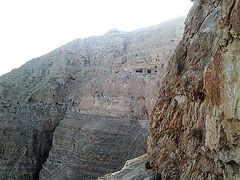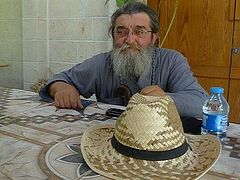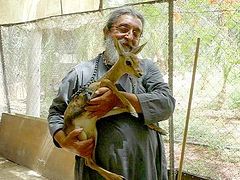 St. Gerasimos of the Jordan. On March 4/17 the Church honors the memory of St. Gerasimos of the Jordan († 475), who first struggled in the desert of the Thebaid (in Egypt), and then settled at the Jordan where he founded a monastery with a very strict rule. For all of Lent, St. Gerasimos would retire without eating anything and only receiving Holy Communion every Sunday.
St. Gerasimos of the Jordan. On March 4/17 the Church honors the memory of St. Gerasimos of the Jordan († 475), who first struggled in the desert of the Thebaid (in Egypt), and then settled at the Jordan where he founded a monastery with a very strict rule. For all of Lent, St. Gerasimos would retire without eating anything and only receiving Holy Communion every Sunday.
One day he encountered an injured lion not far from the monastery. The saint healed it, and the lion began to serve him by performing various obediences, just as the animals obeyed Adam in the Garden of Eden. When the elder fell asleep in the Lord, the lion lay down on his grave and died of melancholy. So St. Gerasimos is depicted with this lion on icons.
The miracles of the saints of God are innumerable. The following story is about one of them. It was recounted by Elder Porphyrios, an ascetic of our time who for thirty-three years (between 1940 and 1973) served in the Church of St. Gerasimos of the Jordan in Athens, helping people find peace of mind, and healing their bodily infirmities.
In The Tourkovounia neighborhood, where we lived, there were very steep slopes. I would wake up very early in the morning, walk to St. Gerasimos’ Church, and come home in the evening. The street where our house stood was steep and potholed.
One morning I fell and broke my leg. It was before dawn, and silence reigned all around. Then several people who had heard my moans came out. They called for an ambulance right away and I was rushed to the hospital. It turned out that I had broken the shin on my left leg. All the bones were splintered. The pain was unbearable. I was brought to the clinic, carried out on a stretcher from the ambulance and put onto a hospital bed in one of the wards. The doctors decided to put a plaster cast on my leg. The faithful waited for me to celebrate the Divine Liturgy but then had to go home.
I lay on the hospital bed for fifteen days. I prayed the whole time. Once I took a look at my legs. And what did I see? By the mercy of God I could see that the plaster cast was applied askew. Then I asked the doctors to remove the cast. Learning about this, the doctor said, laughing:
“This priest isn’t thinking about the Church for which he was ordained—but about how to control us! We've carried out our work well, his leg was X-rayed. What else does he want? To torment us?”
None of the doctors were listening to me. I insisted that they examine my leg one more time. But they did nothing! When they brought me some food for dinner, I refused to eat, repeating that I wanted the doctors to X-ray my broken leg. I kept insisting on them doing this because the leg could knit incorrectly and remain crooked forever. In response to my urgent requests, the doctor said:
“Let him worry about his priestly ministry! Everything is fine with his leg.”
 St. Porphyrios the Kapsokalivite. Evening came. They brought me dinner, but I didn’t eat anything again, insisting that they examine my leg. The next morning the doctor came and said angrily:
St. Porphyrios the Kapsokalivite. Evening came. They brought me dinner, but I didn’t eat anything again, insisting that they examine my leg. The next morning the doctor came and said angrily:
“What’s the matter, Father? What does all this mean? Do you want to torment us?”
After my numerous entreaties I was finally taken to the X-ray room for a second X-ray. And the doctors found that they had indeed applied the plaster cast incorrectly and the bone had already begun to knit.
The doctor laughed:
“Father, we're sorry, we made a mistake. Now it’s clear to me as well. Listen to what we’re going to do with you: We’ll need to break your injured leg and put a plaster cast on the shin again so that it can knit properly.”
He began to hit the cast with all his might to break it. I was silent, only humbly praying.
“Ah, now you are silent,” the doctor said to me. “I’ll ‘grant you absolution!’”
Then he broke the cast and removed it. I felt severe pain. Two doctors pulled my leg and the doctor punched my shin hard with his fist to break it.
“So, Father,” he said, “I’ve forgiven all your sins, but my sins will be forgiven with yours too!”
Then they broke my bone. It had already begun to knit a little. It was awfully painful. I clenched my teeth with pain. I was taken to the X-ray room. Then they connected my bones in the correct position, put the plaster cast on my shin carefully and took me back to the ward.
I lay on a hospital bed for two or three months—I don’t remember exactly. Then the doctors told me to sit on the bed and gave me a pair of crutches so that I could begin to walk a little, leaning on them. I didn’t want to walk with the aid of crutches. The doctor said to me:
“Take these crutches and start to walk little by little, because lying down is tiring.”
I didn’t use the crutches for long as I began to keep my balance unaided. I was afraid to get used to crutches and feared that I would constantly need them.
Then the doctor advised me:
“Buy a walking stick for yourself.”
“I don’t want it,” I replied.
“You’re a priest,” he said. “But you’re stubborn, Father! Listen to me, otherwise you’ll fall somewhere and break all your bones.”
Then I had to tell my sister:
“Please, buy me a stick. Yes, we are poor, but you need to buy me a stick. I don’t want to be on crutches, it annoys me.”
It was eleven o’clock. I got to my church on crutches. My sister was to go to Aiolou Street and buy me a walking stick. But before that my sister had come to the church as well. At the same time a woman with a stick entered the church.
“Is this St. Gerasimos’ Church?” she asked.
“Yes, my daughter,” the church assistant answered her.
“And where is St. Gerasimos’ icon?”
“Here it is.” And she was shown his icon.
The woman knelt down in front of the icon and began to speak aloud with tears in her eyes, so we all could hear her words:
“O holy God-pleaser, I never knew about you, never heard of you, never heard your name. But you condescended to visit me and ask for the walking stick that I bought in Jerusalem. You asked me to bring it to your home. So here I am—I’ve brought you the stick, O holy God-pleaser! You told me, ‘I want you to bring me the stick tomorrow morning!’ I didn’t know where you live and I asked people where your home is. And so I’ve found you here.”
My sister, the church assistant and I were sitting on the stasidia near the pangar.1 The woman approached us and asked:
“Please, tell me what does all this mean? Why did St. Gerasimos ask me to bring him the stick? What does he need it for?”
The church assistant replied:
“Listen, let me tell you why the saint asked for the stick. He personally doesn’t need it, but he has a servant—a priest—and you can see him here in front of you. He broke his leg and was in the hospital for several months, but today he got up and the doctors advised him to get a walking stick. His sister is here—she was just about to go to Aiolou Street and buy him a stick. So take the stick from the saint and give it to the priest.”
Excited, the woman handed the stick to me and kissed my hand:
“Take this stick, Father,” she said to me. “And may the Lord forgive my sins. I bought it in Jerusalem. This stick is from the Holy Sepulcher. I have come here from Patission Street. I live there, and St. Gerasimos appeared to me in a dream.”
I thanked her. I took the stick from the woman’s hands, and once I no longer needed crutches I began to walk with it. I called it “St. Gerasimos’ stick” and came to love it dearly. I took great care in order not to lose it. It was a miraculous stick. Whenever someone was in physical pain, I hit him lightly with the stick and he was healed. Indeed it was a miraculous stick! How nice everything was! How St. Gerasimos took care of me, the least of the servants of God! He appeared to a woman who had never heard about him or about me. The saints do numerous miraculous things, so we must honor them. I praise him in prayers—he’s a healer of the weak, and protects them with his holiness and grace.





